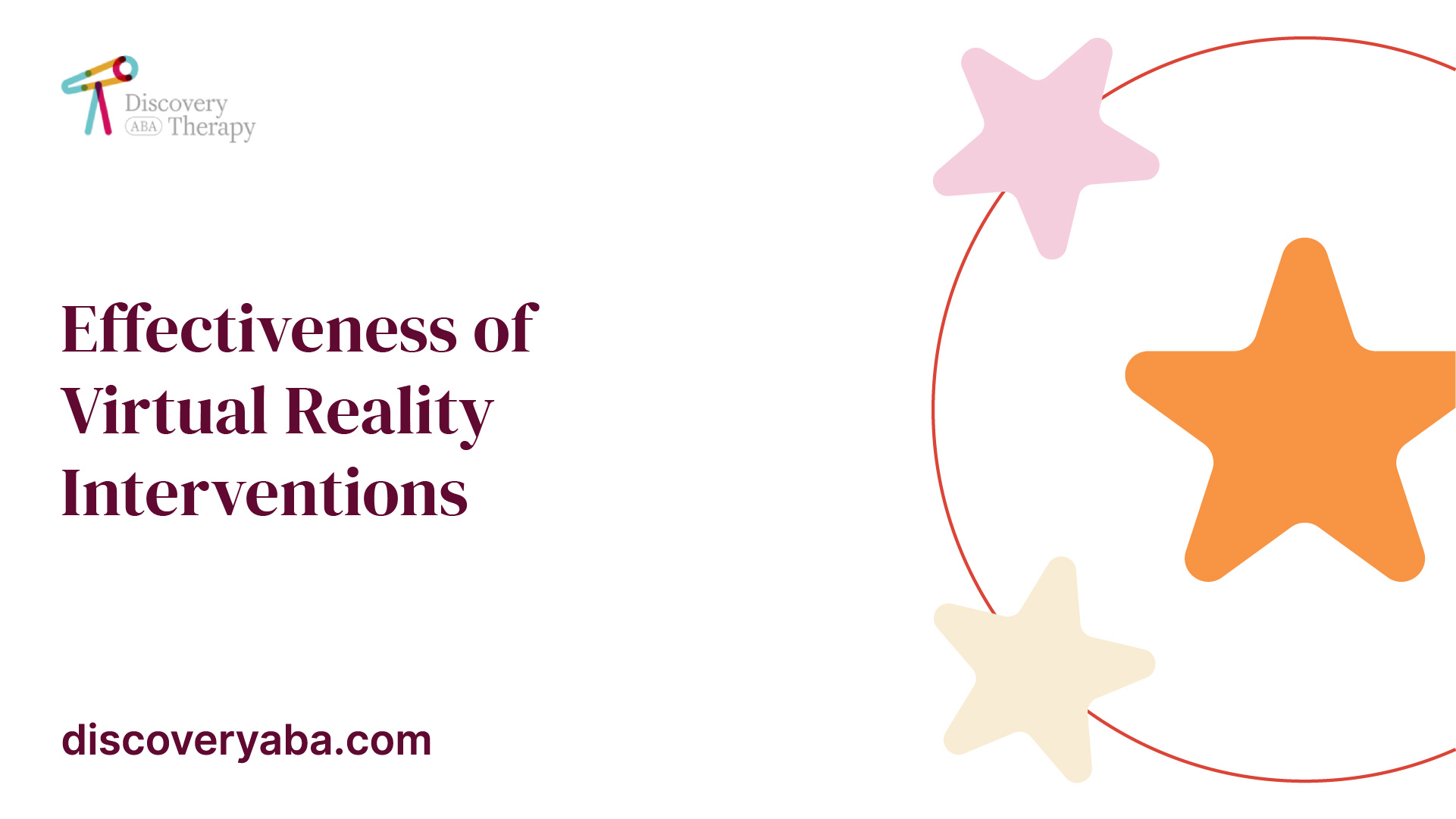Virtual Reality in Autism Therapy
Discover how virtual reality in autism therapy enhances social skills and promotes effective communication.


Utilizing Virtual Reality in Autism Therapy

Benefits of Virtual Reality Therapy
Virtual reality (VR) in autism therapy offers numerous advantages for individuals on the spectrum. Research has demonstrated that VR creates realistic and controlled environments that closely mimic real-life situations. This allows individuals to practice and develop essential life skills, particularly in the realm of social interactions. By providing a safe space for exploration, VR significantly enhances engagement and motivation, fostering skill acquisition through customized scenarios tailored to individual needs [1].
Additional benefits of VR therapy include:
AdvantageDescriptionSafe Learning EnvironmentIndividuals can practice skills without the fear of real-world consequences.CustomizationVR experiences can be tailored to individual preferences and needs.Enhanced Cognitive TrainingVR training can improve attention, memory, problem-solving, and executive functioning skills [1].Effective EngagementThe interactive nature of VR fosters higher levels of participation and commitment.
Enhancing Social Skills
One of the most significant applications of VR therapy for individuals with autism is the enhancement of social skills. VR environments provide immersive experiences where individuals can engage in various social scenarios, enabling them to practice skills such as recognizing emotions, taking turns, and initiating conversations. Studies have highlighted that VR can enhance social cognition and interaction skills more effectively than traditional methods. For example, a study involving emotional training indicated that participants using VR showed shorter acquisition times for identifying primary and secondary emotions compared to those receiving standard training from a therapist [2].
The tailored nature of VR scenarios allows for realistic simulations of social interactions, helping participants to generalize the skills learned in virtual settings to real-world situations.
Practical Applications of VR Therapy
Virtual reality therapy can be applied in a variety of practical settings to benefit individuals with autism. Some examples include:
Through these applications, VR serves as an innovative tool in the realm of autism therapy, offering engaging methods to support skill development and overall personal growth for individuals with autism. Families and caregivers seeking effective strategies and technologies should consider exploring autism therapy best practices to optimize their approach.

Effectiveness of Virtual Reality Interventions1
Virtual reality (VR) has emerged as a promising tool in autism therapy, especially in enhancing skills that are often challenging for individuals on the spectrum. This section focuses on two key areas: improving emotional literacy and enhancing communication skills.
Improving Emotional Literacy
Emotional literacy refers to the ability to recognize, understand, and express emotions. A study showed that children with High Functioning Autism (HFA) using VR for emotional literacy interventions demonstrated significantly shorter acquisition times for recognizing and using both primary and secondary emotions when compared to traditional therapist-led methods NCBI. The immersive nature of VR allows for controlled exposure to various emotional scenarios, which aids individuals in recognizing emotions displayed through facial expressions and body language.
The table below summarizes the findings on emotional literacy improvement between VR interventions and traditional methods:
Type of InterventionAverage Acquisition Time (minutes)VR Intervention (Gr1)15Traditional Therapy (Gr2)25
The effectiveness of VR in this area highlights its potential for fostering deeper emotional understanding and improving overall emotional communication in individuals with autism.
Enhancing Communication Skills
VR interventions have also proven beneficial in enhancing communication skills among individuals with autism. By providing realistic simulations of social interactions, VR allows users to practice social responses, facial expressions, and body language in a safe environment. This immersive approach leads to increased confidence and encourages improved interactions with peers and adults.
Additionally, the use of VR technology supports cognitive functions such as attention, memory, and problem-solving, further aiding in the development of effective communication techniques. For instance, individuals can rehearse specific communication scenarios, helping them feel more prepared and capable in real-life situations.
The following table provides an overview of the effects of VR on communication skills, comparing the progress made by participants in VR interventions versus traditional methods:
Type of InterventionCommunication Skill Improvement (%)VR Intervention68Traditional Therapy45
The results indicate that VR interventions not only enhance emotional literacy but also facilitate significant advancements in communication skills, making it a valuable addition to the therapeutic toolkit for individuals with autism. For more information on specific interventions, explore our resources on autism therapy best practices and autism therapy goals.

Virtual Reality Techniques for Individuals with Autism2
Virtual reality is becoming an innovative tool in autism therapy, providing unique methods to enhance social skills and communication in individuals with autism spectrum disorder (ASD). This section explores tailored experiences and personalized social skill training through VR technology.
Tailored Experiences and Scenarios
Virtual reality interventions offer a three-dimensional perspective that closely mimics reality, presenting a safe environment for individuals with ASD to explore and practice social interactions. These tailored experiences can be customized to meet the specific needs and comfort levels of the individual.
For instance, VR scenarios can simulate various social situations, such as greeting someone, joining a conversation, or participating in group activities. This allows learners to engage in role-playing exercises without the pressure of real-life consequences. The interactivity of the VR environments helps to maintain engagement while reinforcing social cognition skills.
Scenario TypeObjectiveGreeting a peerPractice initiating conversationsGroup activityDevelop teamwork and cooperation skillsOne-on-one discussionImprove turn-taking and active listening
Through personalized scenarios, VR therapy supports the development of important social skills at a pace that resonates with the individual’s learning style.
Personalized Social Skill Training
Personalized social skill training using virtual reality can significantly enhance communication and social interactions among those with autism. Programs designed in virtual environments utilize techniques like natural environment teaching (NET) and discrete trial training (DTT) to foster skill acquisition.
The adaptability of VR allows for customized training focused on specific social cues, emotions, and appropriate responses. The immersive nature of these experiences also engages participants, increasing motivation to practice and improve their skills in a fun and interactive manner.
Additionally, VR technology helps enhance cognitive functions such as attention, memory, and problem-solving, all of which play critical roles in effective communication and social interaction. By integrating these cognitive skills into social training, caregivers and therapists can offer a holistic approach to autism therapy.
Families and caregivers interested in learning more about the potential benefits of virtual reality in autism therapy can explore topics such as autism therapy best practices and autism therapy goals.
Innovations in Virtual Reality for Autism
Innovations in virtual reality are transforming therapeutic approaches for individuals with autism. These advancements offer engaging and supportive tools that enhance the learning and communication skills of those on the autism spectrum.
Interactive Learning Experiences
Virtual reality (VR) provides interactive learning experiences that are essential for the development of social and communication skills in children with autism. VR technology allows users to engage in real-world scenarios within a controlled environment, making learning both safe and enjoyable. For instance, the VR system "My Lovely Granny's Farm" enables children to interact with virtual characters, explore environments, and complete tasks, significantly improving their social interaction and communication abilities.
VR games designed specifically for individuals with autism, such as Playground and Astropolis, facilitate learning important social skills such as sharing and back-and-forth conversation. While these games may not directly lead to specific career paths, they can ignite interests in fields like coding, design, and art.
VR GameSkills DevelopedPlaygroundSharing and communicationAstropolisTeamwork and interactionVivecraftCreativity and designTilt BrushArt and expression
Immersive VR Systems
Immersive Virtual Reality Systems (IVRS) serve as effective tools for improving the communication skills of children with autism. By simulating realistic interactions and environments, IVRS offers a safe space for users to practice and enhance their social abilities. The immersive nature allows experiences to be projected onto the human mind, closely resembling real-life situations [3].
Applications like Floreo use immersive VR to help children learn vital life skills, such as practicing road safety and developing emotional detachment through interactive sensory tools. These applications facilitate key social skills like reciprocity and planning for unforeseen circumstances by leveraging VR to narrate social stories effectively.
The combination of interactive learning experiences and immersive VR systems marks a significant step forward in autism therapy. By harnessing these innovative techniques, caregivers and families can provide tailored support that meets the unique needs of individuals with autism. For more information about autism therapy best practices, check our article on autism therapy best practices.
Advantages of Virtual Reality in Autism Treatment
Virtual reality (VR) therapy offers several compelling advantages for individuals with autism. Through innovative applications of this technology, families and caregivers can facilitate more effective treatment plans.
Engagement and Motivation
One of the primary benefits of using virtual reality in autism therapy is the enhanced engagement and motivation it provides. When VR is combined with gamified approaches, it significantly boosts attention and focus among individuals with Autism Spectrum Disorder (ASD). This innovative method creates a novel environment for learning, making tasks enjoyable and interactive, which can lead to improved skill generalization [5].
AspectInfluenceAttentionIncreased focus on tasksMotivationEnjoyable learning experienceEngagementInteractive environment
Skill Generalization and Personalized Therapy
VR technology allows for personalized therapy experiences tailored to the needs of each individual with autism. This customization is crucial as it enables individuals to rehearse appropriate social responses, facial expressions, and body language in a controlled setting. Consequently, this leads to increased confidence and improved social interactions [1].
In addition to enhancing social skills, VR also promotes functional independence by targeting cognitive abilities such as attention, memory, and problem-solving through training exercises. This comprehensive approach not only helps individuals practice essential skills but also fosters generalization across various real-world contexts [1].
Families looking to support their loved ones can explore more about effective strategies by visiting our resource on autism therapy best practices or learn about specific autism therapy goals that can be integrated into treatment plans.
By leveraging the advantages of VR technology in autism treatment, it is possible to create engaging, motivating, and personalized experiences that cater to the individual’s unique needs and skills.
The Future of Virtual Reality in Autism Care
As technology progresses, the integration of virtual reality (VR) in autism therapy is expected to expand significantly. Continued research and development in this field may enhance its efficacy and accessibility for families and caregivers of individuals with autism.
Continued Research and Development
Ongoing studies are crucial to understanding the full potential of VR applications in autism treatment. Research indicates that VR technologies enable repeated practice and exposure, vital components in effective therapy NCBI. This aspect of VR therapy allows individuals with Autism Spectrum Disorder (ASD) to learn through experience rather than rote memorization.
Benefits of VR Research:
BenefitDescriptionReduced StressVR can create a calming environment, minimizing anxiety during sessions.Increased MotivationGamification and engaging scenarios can enhance participation.Enhanced FocusImmersive environments may improve attention levels in individuals with ASD.Support for Lower-Functioning PopulationsTailored VR experiences cater to diverse needs within the ASD community.
Potential Impact on Autism Spectrum Disorder
The future impact of virtual reality on autism care is substantial. VR has the ability to create customized scenarios and interlocutors, essential for effective social communication training. This customization allows therapists to design and control environments that closely replicate real-world situations, facilitating meaningful skill practice.
VR therapy not only provides opportunities for skill acquisition but also promotes engagement and motivation through gamified approaches. These innovations may spearhead new methods for supporting autism therapy, leading to potential breakthroughs in treatment outcomes. For more resources on effective autism therapy practices, review our section on autism therapy best practices.
References
[2]:
[3]:
[4]:
[5]:
Find More Articles

How to Handle Tantrums Using ABA Strategies

How ABA Therapy Addresses Repetitive Behaviors in Autism

How ABA Therapy Can Improve Sleep Patterns for Children with Autism

The Role of Generalization in Teaching Lasting Skills Through ABA Therapy

The Connection Between ABA Therapy and Improved Quality of Life

How ABA Therapy Supports Structured Learning in a Classroom Environment

How to Use ABA Strategies to Support Toilet Training

How to Use ABA Strategies to Support Toilet Training

Green Living Spaces for Autism Families

How ABA Therapy Supports Long-Term Independence and Life Skills

How ABA Therapy Supports Long-Term Independence and Life Skills

The Connection Between ABA Therapy and Emotional Regulation

How ABA Therapy Helps with Goal Achievement for Teens

How to Help Children Develop Self-Monitoring Skills with ABA Strategies

How to Use Prompting and Fading Techniques in ABA Therapy

How to Address Tantrums and Meltdowns with ABA Therapy

The Role of Visual Supports in ABA Therapy Sessions

How to Address Feeding Issues with ABA Therapy

How to Create a Structured Routine with ABA Techniques

How to Help Your Child Transition Between ABA Therapy and School

How to Address Impulsivity with ABA Therapy

The Connection Between ABA Therapy and Long-Term Skill Retention

How ABA Therapy Can Be Adapted for Different Learning Styles

The Connection Between Play and Learning in ABA Therapy

How to Make ABA Therapy Fun and Engaging for Your Child

ABA Therapy for Children with Severe Autism

How to Use ABA Therapy Techniques to Build Self-Care Skills

The Importance of Consistency in ABA Therapy Implementation

The Role of ABA Therapy in Teaching Self-Management Skills

How to Address Self-Stimulatory Behaviors in a Supportive Way

The Importance of Functional Communication Training in ABA Therapy

How Renewable Energy Supports Autism Communities

The Benefits of a Structured ABA Therapy Program

Creating Eco-Friendly Spaces for Autism

The Benefits of Parent-Implemented ABA Therapy Strategies

The Importance of Reinforcement Schedules in ABA Therapy

How to Support a Child with Autism in Group Learning Environments

The Connection Between ABA and Emotional Regulation

How ABA Therapy Helps Reduce Repetitive and Rigid Behaviors

Energy-Efficient Autism Community Resources

How to Use ABA Therapy to Reduce Excessive Repetitive Behaviors

The Role of Play in ABA Therapy

The Benefits of Combining ABA Therapy with Other Support Services

How ABA Therapy Helps Develop Self-Confidence in Children with Autism

How ABA Therapy Helps Develop Self-Confidence in Children with Autism

The Role of Play-Based ABA Therapy in Early Childhood Development

The Role of Goal-Oriented Sessions in ABA Therapy

How ABA Therapy Works: A Step-by-Step Guide

The Role of Self-Management Strategies in ABA Therapy

How ABA Therapy Supports Emotional Expression in Children

The Role of Parent Training in ABA Programs

How ABA Therapy Supports Positive Transitions Between Activities

How to Reinforce ABA Learning in Community Settings

The Role of Functional Behavior Assessments in Preventing Problem Behaviors

How School-Based ABA Therapy Supports Classroom Success

How to Choose Between At-Home and Center-Based ABA Therapy

How to Choose Between At-Home and Center-Based ABA Therapy

How ABA Therapy Helps Develop Conflict Resolution Skills

How to Identify the Best ABA Provider for Your Child

How to Use Token Economies in ABA Therapy

The Role of Peer Modeling in ABA Therapy Success

The Benefits of Naturalistic Teaching Approaches in ABA Therapy

What Is the ABCs of Behavior in ABA Therapy?

The Benefits of Group ABA Therapy for Social Skill Development

How to Encourage Positive Social Interactions with ABA Strategies

How to Introduce New Skills in ABA Therapy Without Overwhelming Your Child

The Benefits of Combining ABA Therapy with Other Interventions

Solar Power for Autism Support Networks

How to Address Hyperactivity with ABA Therapy

Common Misconceptions About ABA Therapy

Understanding the Principles of Positive Reinforcement

Understanding the Principles of Positive Reinforcement

Understanding the Principles of Positive Reinforcement

How ABA Therapy Supports Transitions Between Activities

Understanding the Principles of Positive Reinforcement

How to Identify and Celebrate Small Successes in ABA Therapy Progress

Understanding the Principles of Positive Reinforcement

How to Introduce Visual Schedules for Better Behavior Management

How ABA Therapy Can Reduce Self-Injurious Behaviors

How ABA Therapy Supports Academic Success

The Importance of Early Signs Recognition and ABA Intervention

How ABA Therapy Helps Improve Comprehension and Listening Skills

How to Use Visual Schedules to Support Your Child’s ABA Goals

How ABA Therapy Supports Self-Help Skills Like Dressing and Eating

How ABA Therapy Supports Behavioral Success in Community Settings

How ABA Therapy Helps Build Independence in Daily Activities

Building Social Skills Through ABA Therapy Techniques

The Role of School-Based Behavior Intervention Plans (BIPs)

The Benefits of Scripting and Role-Playing in ABA Therapy

How to Help Your Child Develop Coping Strategies with ABA Therapy

How to Address Hyperactivity and Attention Challenges with ABA Therapy

How to Help Your Child Develop Coping Strategies with ABA Therapy

How ABA Therapy Addresses Challenging Behaviors

The Importance of Social Skill Groups in ABA Therapy

How ABA Therapy Addresses Challenging Behaviors

The Role of Task Analysis in ABA Therapy for Teaching New Skills

How ABA Therapy Helps Improve Focus and Attention in the Classroom
%2520(1).jpeg)
Assessment Tools For People With Autism

Autism And Chronic Pain

How to Use Social Stories to Enhance ABA Therapy Outcomes
Contact us
North Carolina, Tennessee, Nevada, New Jersey, Utah, Virginia
New Hampshire, Maine
Massachusetts, Indiana, Arizona, Georgia
.avif)
